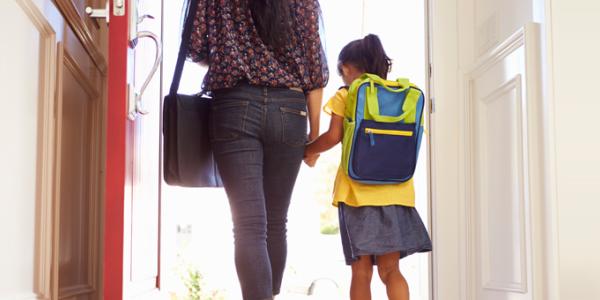Personal Stories to Help Children Get Ready for School

You are here
By: Jesemine Jones and Ida Keiper
For some children, getting ready to start school is exciting and fun. Nevertheless, the start of the school year can also be overwhelming and anxiety provoking for children who are fearful when anticipating new situations.
What can families do to help prepare their child for school?
One way to help prepare your child for school is to use what educators call a visual support, to help your child handle transitions. An example of a visual support is a personal story, written and illustrated with your child in mind. Stories are effective with children of all ages and abilities. A story can describe the new situation, including what your child will be expected to do, and how he or she might feel in the new setting.1 Writing a story with your child can also help illustrate where they are going, who they will meet, what they will do, and how children are expected to behave at school.
Here is an example of a story written by Jamie’s mom:
Jamie Goes To Kindergarten
I will be going to Kindergarten in September. This will be my first time in the big kid school.
I will ride on a bus to school in the morning.
My mom or dad will wave goodbye, and blow me a kiss while I look out the window.
I will miss my family, but someone will be waiting for me when I finish school.
I may cry a little, but that is okay.
I will feel better after a few days.
When I get off the bus, I will get in line with my class.
My teacher will meet me at door.
I am happy to see my new classroom.
When I walk into my classroom, I will find my cubby with my name on it and put my things inside.
My new classroom has so many fun things to do. There are toys, books, and computers.
I will meet new friends. I may feel scared about meeting new friends, but I will be friendly and say hello.
I will learn how to read, write, and do math in my classroom. YEAH!
Other days, I will walk with my classmates to go to the gym or the art room. It may be hard for me to have a new teacher, but I will be okay.
At lunchtime my class will walk to the cafeteria to eat. It may be very crowded and noisy. That’s okay! Everyone is just having fun. After a few days I will get use to the noise.
After lunch I will go outside to the playground. YEAH!
At the end of the day, I will say goodbye to my new friends and teacher and get back on the bus to go home.
I will be happy to see mom and dad.
I had a great first day at school.
Help your child write a story about going to school!
Materials you’ll need:
Photos, small notebook, glue, marker
Steps
1. Take photographs relevant to your child’s experience. These could include: the vehicle your child will ride in to get to school, family members, the school building, their teacher(s), classroom, gym, art room, cafeteria, and playground. (If you can’t take photos, download pictures from the school website, copy them from a school year book, use clip art, or draw pictures [with your child’s help]). Arrange the photos in order so they describe your child’s day. Glue them to the pages of a small blank notebook. Leave room under each picture to write a sentence.
2. Write a story
- Include your child's name in the title - "Jamie Goes to Kindergarten."
- Include a few pages as introduction, a few that tell most of the story, and a conclusion—what happens at the end of the day.
- Write the story at a level your child will understand.
- Use who, what, when, where, how, and why statements to tell the story. Include details appropriate to your child’s age and the concerns your child might have about school.
- Write in the first person, as if your child was telling the story. For example, “I will meet my teacher on the first day of school.”
3. Read the story with your child before the big day—as often as your child wants to hear it. As you read aloud and discuss the story, you may learn of new concerns about going to school that you did not write about. You can discuss the concerns or add them to the story. If your child is able, leave the story in your child’s room so they can have access to it, and encourage them to read it before the big day.
4. Reinforce your child’s efforts. Give praise when they read the story with you or on their own.
1 Social StoriesTM is a well-known example of a story-based strategy and was developed by Carol Gray, President of The Gray Center.
Educators Jesemine Jones and Ida Keiper are authors of the Starbrite Traveler books for parents. They have 50 years of combined experience educating children with a broad spectrum of disabilities. Ms. Jones earned a Masters of Social Work from Rutgers University as well as a B.A. in Special Education from Georgian Court University. She is currently a social worker in the New Jersey public school system. Ms. Keiper earned a B.A. from Georgian Court University. She has educated children with disabilities for thirty years in New Jersey public schools.